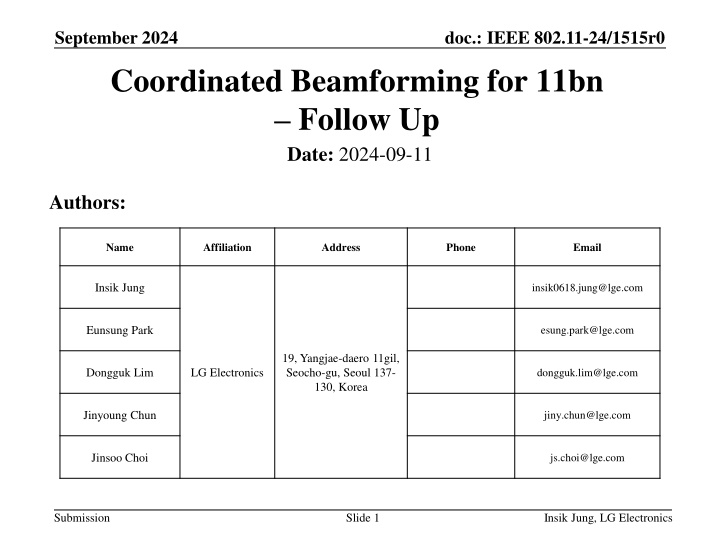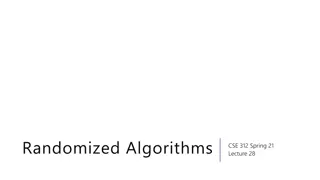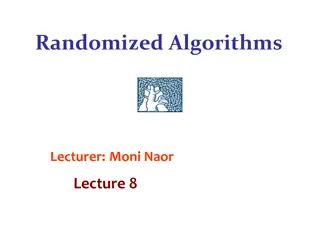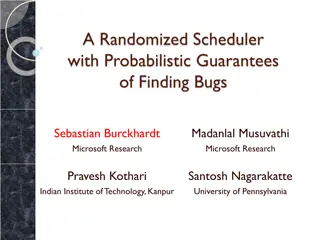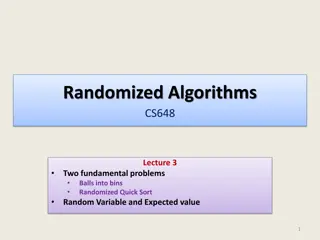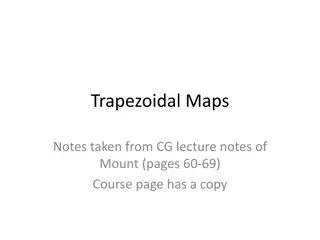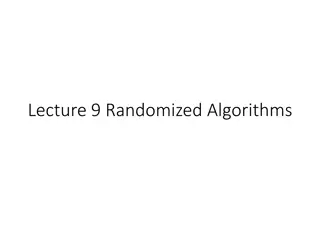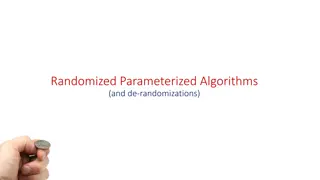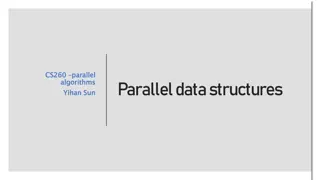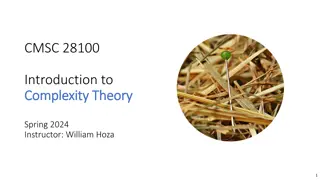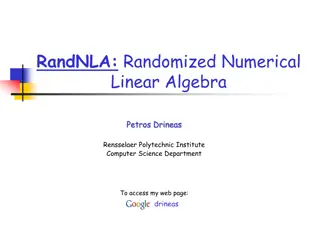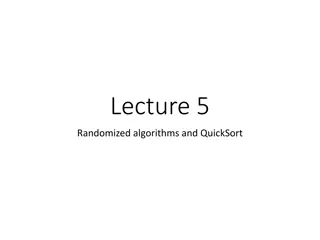Randomized Algorithms - Lecture Insights
Uncover the intricacies of randomized algorithms in this lecture series, covering topics ranging from 2-SAT and 3-SAT to Probabilistic Turing Machines and language recognition. Delve into complexity classes like BPP, ZPP, and RP, exploring decision problems and strong vs. weak BPP scenarios. Engage with the course material from esteemed authors Mitzenmacher, Upfal, Motwani, and Raghavan, gaining a deeper understanding of the probabilistic method. Enhance your knowledge through discussions on Monte Carlo vs. Las Vegas algorithms, with homework assignments focusing on hitting set for RP. Explore the theoretical foundations and practical applications of randomized algorithms in a comprehensive learning experience.
Download Presentation

Please find below an Image/Link to download the presentation.
The content on the website is provided AS IS for your information and personal use only. It may not be sold, licensed, or shared on other websites without obtaining consent from the author.If you encounter any issues during the download, it is possible that the publisher has removed the file from their server.
You are allowed to download the files provided on this website for personal or commercial use, subject to the condition that they are used lawfully. All files are the property of their respective owners.
The content on the website is provided AS IS for your information and personal use only. It may not be sold, licensed, or shared on other websites without obtaining consent from the author.
E N D
Presentation Transcript
September 2024 doc.: IEEE 802.11-24/1515r0 Coordinated Beamforming for 11bn Follow Up Date: 2024-09-11 Authors: Name Affiliation Address Phone Email Insik Jung insik0618.jung@lge.com Eunsung Park esung.park@lge.com 19, Yangjae-daero 11gil, Seocho-gu, Seoul 137- 130, Korea Dongguk Lim LG Electronics dongguk.lim@lge.com Jinyoung Chun jiny.chun@lge.com Jinsoo Choi js.choi@lge.com Submission Slide 1 Insik Jung, LG Electronics
September 2024 doc.: IEEE 802.11-24/1515r0 Introduction Coordinated beamforming (C-BF) is multi-AP transmission technology which will be defined in 11bn [1]-[5]. In [6], C-BF precoding methods and its performance has been investigated for single-user MIMO (SU- MIMO) We observed that full nulling provides throughput gain compared to single-AP systems and partial nulling provides additional gain In this contribution, we discuss the MU-MIMO precoding method and its performance, which is expected to provide improved performance gain. Submission Slide 2 Insik Jung, LG Electronics
September 2024 doc.: IEEE 802.11-24/1515r0 System Model Topology 8 antenna AP, 2 antenna STAs 2 spatial streams for each STA (2+2+2+2) We assume that AP 1 and 2 are symmetric. Thus, we focus on investigating AP 1 s behavior AP 1 AP 2 ?14 ?11 ?12 ?13 STA 1 STA 3 STA 2 STA 4 SNR STA to in-BSS AP: SNR (dB) STA to OBSS AP: SNR-X (dB) In-BSS Channel OBSS Channel Submission Slide 3 Insik Jung, LG Electronics
September 2024 doc.: IEEE 802.11-24/1515r0 MU-MIMO Precoding for Full Nulling(1/2) Two-step Precoder Matrix ?11 ?12 ????? ????? + ? Interference Nulling Obtaining beamforming gain Interference Nulling Precoding (?????) In-BSS inter-user-interference In STA 1 side, interference matrix can be decomposed as ?12= ?12 12?12 In STA 2 side, interference matrix can be decomposed as ?11= ?11 11?11 OBSS inter-user-interference ?13= ?13 13?13 Null Precoder ? ? ?, ?14= ?14 14?14 ? ? ? ?12 ?13 ?14 ?11 ?13 ?14 For STA 1, ) . For STA 2, ? ? ) ?????= ?2 ?1= ????( ?2= ????( ?1 ? ? Submission Slide 4 Insik Jung, LG Electronics
September 2024 doc.: IEEE 802.11-24/1515r0 MU-MIMO Precoding for Full Nulling(2/2) After Null precoding, equivalent matrix becomes as follows ?11 ?12 ?11 ?12 ?11 0 ?11 ?12 ?1 ?1 ?2 ?2 ?1 0 ?1 ?2= = ?12 ?2 BSS IUI is nullified SVD Precoding for each STA (????) We then apply SVD beamforming to each user for the BF gain 1 ?1 2 ?1 ?2 For STA 1, equivalent channel ?11 For STA 2, equivalent channel ?12 ?1= ?2= ? ?1 0 0 ?2 ????= ? ?2 Total precoding matrix becomes: ?1 0 0 ?2 ?11 ?12 ?1 ?2 Submission Slide 5 Insik Jung, LG Electronics
September 2024 doc.: IEEE 802.11-24/1515r0 MU-MIMO Precoding for Partial Nulling (1/2) Two-step Precoder Matrix ?11 ?12 ????? ????? + ? Interference Nulling Precoding (?????) In-BSS inter-user-interference In STA 1 side, interference matrix can be decomposed as ?12= ?12 12?12 In STA 2 side, interference matrix can be decomposed as ?11= ?11 11?11 OBSS inter-user-interference ?13= ?13 13?13 Null Precoder ? ? ?, ?14= ?14 14?14 ? BSS IUI is fully eliminated ? ? ?12 ?(:,1) ?14 ?11 ?(:,1) ?14 For STA 1, ) . For STA 2, ) ?1= ????( ?2= ????( ?13 ?13 ?(:,1) ?(:,1) ?????= ?2 OBSS IUI is partially eliminated ?1 Submission Slide 6 Insik Jung, LG Electronics
September 2024 doc.: IEEE 802.11-24/1515r0 MU-MIMO Precoding for Partial Nulling (2/2) After Null precoding, equivalent matrix becomes as follows ?11 ?12 ?11 ?12 ?11 0 ?11 ?12 ?1 ?1 ?2 ?2 ?1 0 ?1 ?2= = ?12 ?2 BSS IUI is nullfied SVD Precoding for each STA (????) We then apply SVD beamforming to each user for the BF gain 1 ?1 2 ?1 ?2 For STA 1, equivalent channel ?11 For STA 2, equivalent channel ?12 ?1= ?2= ? ???? ?1(:,1:2) 0 ? 0 ?2 = ?2(:,1:2) Total precoding matrix becomes: ?1 0 0 ?2 ?11 ?12 Eigenvalue selection gain can be obtained ?1 ?2 Submission Slide 7 Insik Jung, LG Electronics
September 2024 doc.: IEEE 802.11-24/1515r0 Simulation Environment Bandwidth 80MHz Data size 8000 bits Channel Model TGnD Channel Coding LDPC Channel Estimation Realistic Baseline Single AP MU-MIMO. Especially when only one BSS is transmitting data(i.e., simply assuming one BSS can transmit at a time like C-TDMA(no interference/collision assumed)). Submission Slide 8 Insik Jung, LG Electronics
September 2024 doc.: IEEE 802.11-24/1515r0 Simulation Result (1/2) FER Basically, single-AP is lower bound of FER performance since it is not affected by interference. When X is small, full nulling outperforms partial nulling Since interference level is too high, concentrating on interference elimination performs better When X is large, partial nulling outperforms full nulling. FER is so close to single-AP, which means that throughput can be much higher than single-AP Submission Slide 9 Insik Jung, LG Electronics
September 2024 doc.: IEEE 802.11-24/1515r0 Simulation Result (2/2) Throughput Overall, C-BF outperforms Single-AP system in most of the SNR region One exception is partial null with X=0dB. This is because the effect of residual interference cannot be sufficiently compensated by beamforming gain. When X is 40dB, partial nulling precoding provides meaningful throughput gain compared to the full nulling precoding. Submission Slide 10 Insik Jung, LG Electronics
September 2024 doc.: IEEE 802.11-24/1515r0 Thoughts on Sounding & Feedback To perform null precoding, each AP requires the channel information which goes to the OBSS STAs. Thus, we may need to define the OBSS sounding procedure as proposed in [7]-[11]. One thing to note is that we may not need some columns of the OBSS channel matrices, if AP is going to apply partial nulling precoding. Thus, we may reduce the feedback overhead of the OBSS sounding by not transmitting some of columns of the OBSS channel matrix Submission Slide 11 Insik Jung, LG Electronics
September 2024 doc.: IEEE 802.11-24/1515r0 Conclusion We have investigated the MU-MIMO precoding methods for coordinated beamforming Two different precoders (full nulling, partial nulling) have been handled We then evaluated the performance of the precoders It has been shown that partial nulling precoding can be beneficial in some OBSS interference condition. We also discussed the OBSS sounding feedback mechanism which can be considered for C-BF The feedback overhead of OBSS sounding can be reduced by transmitting partial information which is another benefit of the proposed method Submission Slide 12 Insik Jung, LG Electronics
September 2024 doc.: IEEE 802.11-24/1515r0 References [1] 11-19-0772-01, Multi-AP Collaborative BF in IEEE 802.11 [2] 11-23-0776-01, Performance of C-BF and C-SR [3] 11-23-1998-00, Zero-MUI Coordinated Beamforming [4] 11-24-0011-00, Coordinated Spatial Nulling (C-SN) Concept [5] 11-24-0012-00, Coordinated Spatial Nulling (C-SN) Simulations [6] 11-24-1204-00, Coordinated Beamforming for 11bn [7] 20-0123-00, Channel Sounding for Multi-AP CBF [8] 19-1535-00, Sounding for AP Collaboration [10] 19-1134-00, Consideration of Multi AP Sounding [11] 19-1593-00, Joint Sounding for Multi-AP Systems Submission Slide 13 Insik Jung, LG Electronics
September 2024 doc.: IEEE 802.11-24/1515r0 Straw Poll #1 Do you agree to support partial nulling precoding for coordinated beamforming in 11bn? Partial nulling precoding denotes that AP makes a null precoder using only part of the column vectors of its compressed OBSS channel matrix Y/N/A: // Submission Slide 14 Insik Jung, LG Electronics
